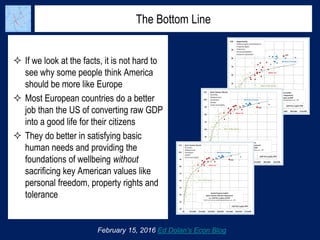Why Should America Be More Like Europe?
- 1. Economics Issues from Ed Dolan’s Econ Blog Why Does Anyone Think America Should be More Like Europe? Some Reasons Posted February 15, 2016 Terms of Use: These slides are provided under Creative Commons License Attribution—Share Alike 3.0 . You are free to use these slides as a resource for your economics classes together with whatever textbook you are using. If you like the slides, you may also want to take a look at my textbook, Introduction to Economics, from BVT Publishing.
- 2. Should America Be More Like Europe? The idea that liberals want to make America more like the rest of the world has become a favorite Republican attack line of the 2016 presidential campaign Conservatives are especially hostile to trying to make America more like Europe February 15, 2016 Ed Dolan’s Econ Blog “Barack Obama is undertaking a systematic effort to change this country, to make America more like the rest of the world.” —Sen. Marco Rubio New Hampshire Republican Debate, Jan. 2016
- 3. Some Liberals Do Openly Admire Europe In a recent interview on ABC, George Stephanopoulos cautioned Sanders that Republicans were likely to jump all over him for saying the U.S. should be more like Scandinavia. "That's right. And what's wrong with that?" Sanders replied. February 15, 2016 Ed Dolan’s Econ Blog Sen. Bernie Sanders speaking before Iowa Caucuses, January 2016
- 4. Let’s Look at Some Data To understand why some people want America to look more like Europe, let’s look at some data Specifically, let’s look at the Social Progress Index, (SPI) which shows how well countries convert raw GDP into good lives for their citizens February 15, 2016 Ed Dolan’s Econ Blog Components of the Social Progress Index: Basic Human Needs (nutrition, basic medical care, access to clean water, sanitation, shelter, and security from crime and terrorism) Foundations of Wellbeing (literacy and quality of primary education, access to mobile phones and internet, life expectancy, and environmental quality) Opportunity (political rights, freedom of speech and religion, property rights, tolerance, freedom of personal choice, and access to higher education)
- 5. SPI vs. GDP: An Overview This chart shows that the Social Progress Index increases as GDP per capita increases (black trendline) The US does an average job of converting raw GDP to a good life for its citizens (it is right on the trendline) Most European countries outperform the US on the SPI, in many cases even when their GDP per capita is lower February 15, 2016 Ed Dolan’s Econ Blog
- 6. Basic Human Needs Northern European countries (blue dots) all do better than the US in providing basic human needs The US is below the trendline—it does worse than expected for such a wealthy country Most of the middle-income countries of Eastern and Southern Europe (red squares) also do a better than expected job of providing for basic human needs February 15, 2016 Ed Dolan’s Econ Blog
- 7. Foundations of Wellbeing The picture is similar for the Foundations of Wellbeing component of the SPI The US performs below the global trend Most European countries do better than expected, given their level of income February 15, 2016 Ed Dolan’s Econ Blog
- 8. Opportunity The “Opportunity” component of the SPI is rich in indicators valued by conservatives, like personal freedom, property rights, and tolerance The US performs well by these indicators, but not greatly above wealthy Northern European countries February 15, 2016 Ed Dolan’s Econ Blog
- 9. The Bottom Line If we look at the facts, it is not hard to see why some people think America should be more like Europe Most European countries do a better job than the US of converting raw GDP into a good life for their citizens They do better in satisfying basic human needs and providing the foundations of wellbeing without sacrificing key American values like personal freedom, property rights and tolerance February 15, 2016 Ed Dolan’s Econ Blog
- 10. Click on the image to learn more about Ed Dolan’s Econ texts or visit www.bvtpublishing.com For more posts and slideshows, Follow Ed Dolan’s Econ Blog Follow @DolanEcon on Twitter










